Partners in Conservation
Learn about the Zoo’s financial commitment to holistic conservation efforts in Central Africa.

by Greg Lipps, Amphibian and Reptile Conservation Coordinator for The Ohio State University
The date was September 20, 2023, and it’s one I won’t soon forget.
On that day, we discovered one of our zoo-reared eastern hellbenders – collected as an egg in 2013 and released as a 3-year-old in 2016 – guarding a nest of eggs.
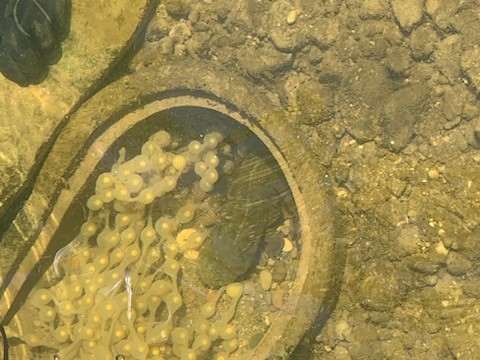
This was, of course, exactly what we had always hoped to see: an animal born and raised at a zoo, released back into the wild, going on to reproduce and help reverse the decline of this iconic species.
This wasn’t the first great milestone we celebrated in 2023. In fact, we had earlier celebrated finding this male on September 6. He had taken up residence in one of our Hellbender Huts, an artificial concrete shelter that had been placed into the river to provide additional homes for hellbenders. Think of a bluebird box, if bluebirds lived in the cavities under giant rocks in streams.
The idea for a Hellbender Hut originated half-way around the world. Hellbenders are one of only three living species in the family Cryptobranchidae (“hidden gills”). Although they are Ohio’s largest salamander, reaching lengths of over 2 feet and weights approaching 3 pounds, within their family, they are the “little” guys. Their family includes the Japanese giant salamander (Andrias japonicus) which can grow to 5 feet and 55 pounds, and the Chinese giant salamander (Andrias davidianus), the largest living amphibian in the world, which can reach up to 5.9 feet long and 110 pounds!
In 2010, I joined Missouri’s state herpetologist, Jeff Briggler, and Mark Wanner, then the zoological manager of herpetology at the Saint Louis Zoo, on a trip to Japan to learn more about their giant salamander.
Of particular interest to us were the Hanzaki Blocks (Hanzaki being the local word for the Japanese giant salamander). Unlike hellbenders, Japan’s giants breed in burrows in the banks of the river. These burrows are especially vulnerable to destruction when stream banks are modified, leading the Japanese researchers to design an artificial burrow for their salamanders. They worked.
Upon our return home, Jeff and his crew at the Missouri Department of Conservation began creating and deploying several different model Hellbender Huts. It didn’t take long before they found a design that worked, one in which wild hellbenders took up residence. The winning design mimics a tunnel, a small entrance that might be found under a big rock, leading back to a cozy cavity.
When Jeff shared the design with me, I went looking for a concrete precast company that could turn these out. And, with the financial support from the Columbus Zoo’s Conservation Fund, a concrete mold was made, and Ohio’s first Hellbender Huts were landing in streams across the state.
My trip to Japan came at the end of a five-year Ohio Division of Wildlife funded survey to determine the status of the eastern hellbender in Ohio. With my mentor and the first biologist to conduct a statewide survey of the species in the mid-1980s, the late Ralph Pfingsten, we logged nearly 1,500 person-hours in Ohio streams, lifting big rocks and scooping up hellbenders to be weighed, measured, and permanently tagged with a tiny microchip the size of a grain of rice before releasing them back at their point of capture. Staff at The Wilds and the Columbus Zoo and Aquarium were regular field hands in these early days, not only helping us with the surveys, but collecting data on the health of the animals and water quality in the streams.
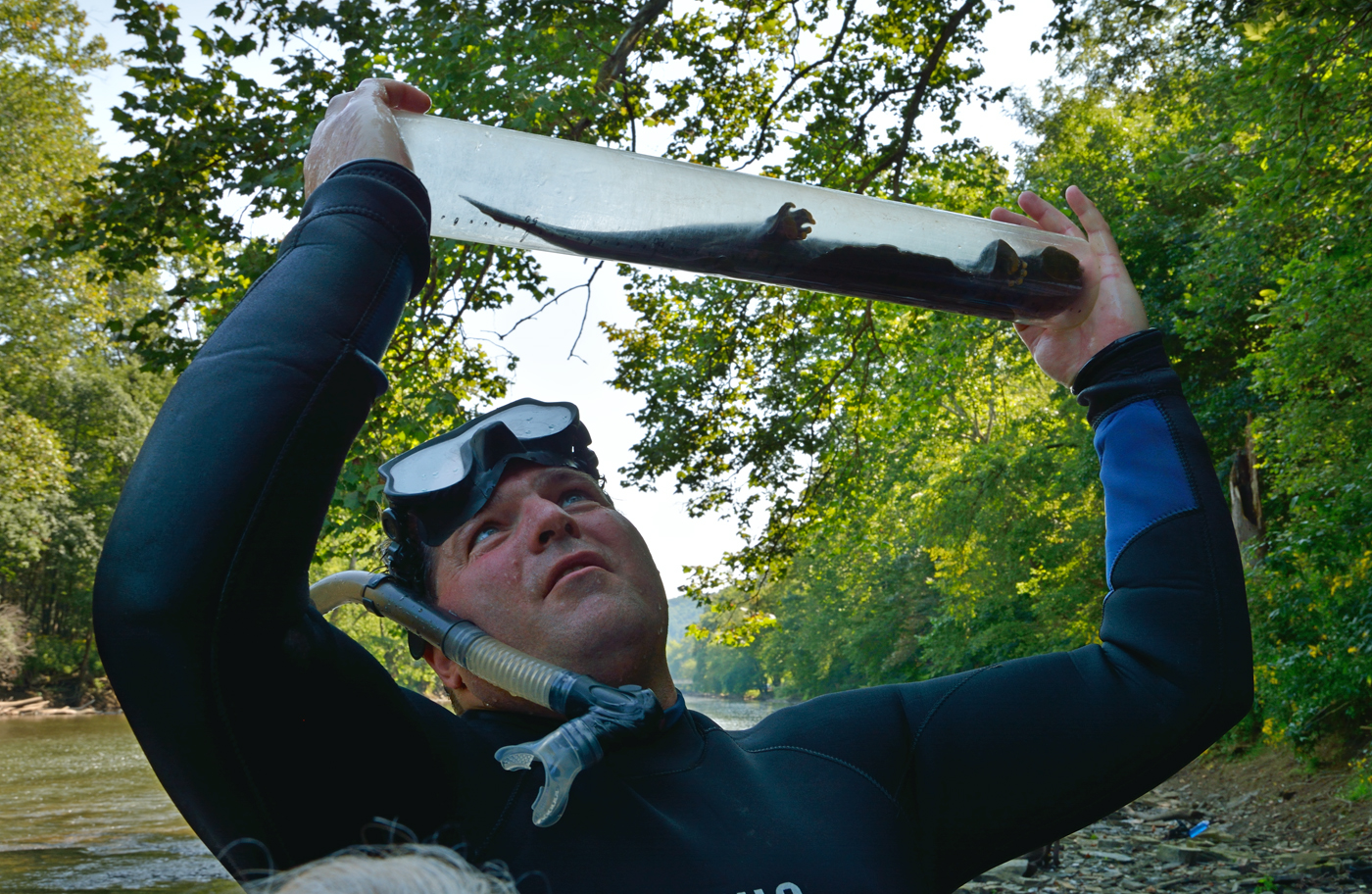
Spending my summers searching for hellbenders with Ralph was a dream come true for me, but the results were not. In comparison to Ralph’s surveys 20 years previous, we were finding a lot fewer hellbenders. Our captures per person-hour searching averaged 82% less, and what we were finding were mostly large, old adults. Most of Ohio’s streams were hellbender convalescent homes; no youngsters waiting to take the place of their elders.
At the end of the statewide survey, the Ohio Division of Wildlife asked me to create a conservation plan for the species, a blueprint for how to recover the species. In 2011, eggs were collected from a wild hellbender nest – only the second ever documented in the state – and brought to the Columbus Zoo to be hatched and reared. This was the beginning.
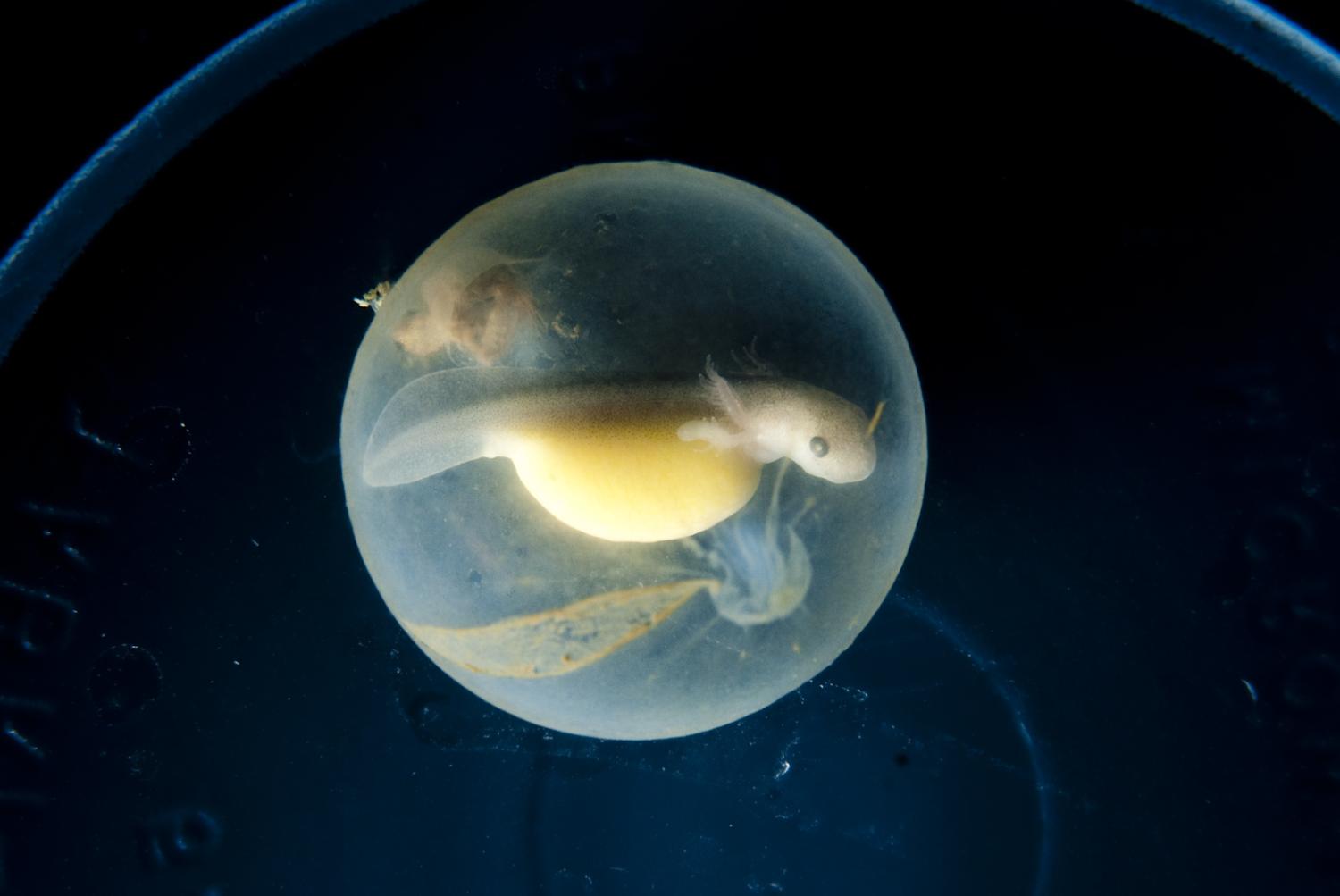
Fast forward to 2023, when the total number of nests located in Ohio now stands at 45, and nearly 1,900 head-started hellbenders have been released back into Ohio waterways. Most of these were reared for three years, all in biosecure facilities at the Columbus Zoo, the Toledo Zoo & Aquarium, and Penta Career Center. We’ve been very successful, finding nests every year, and learning how to better care for the eggs and young hellbenders during their aquarium years.
But it wasn’t until September 2023 that we had our true measure of success. Waving a scanner over the hellbender’s body, we detected a microchip, a passive integrated transponder (PIT) placed into each hellbender prior to release. The scanner read 982000365430857. From this, we know that our hellbender came from eggs collected on September 11, 2013 and brought to the Toledo Zoo. In February 2015, a group including this individual was transferred to the Columbus Zoo for another year and a half of growing before being released on August 23, 2016. It’s final weigh-in before release was 85.5 grams and a total length of 25.7 centimeters. When we found him this year, the proud papa was now 529.9 grams and 42 centimeters.
The same week brought more good news. In another watershed, we located three more of our head-started hellbenders residing in Hellbender Huts. Two of these were also with eggs!
The success of this program is the success of the Ohio Hellbender Partnership, a group of individuals representing Ohio zoos, wildlife and environmental agencies, park districts, soil and water conservation districts, land trusts, and researchers who meet regularly to keep working towards our goal of recovering the eastern hellbender in Ohio. Our two-prong approach – restoring and protecting habitat and head-starting hellbenders to bolster populations – means we need people and institutions that can address both needs.
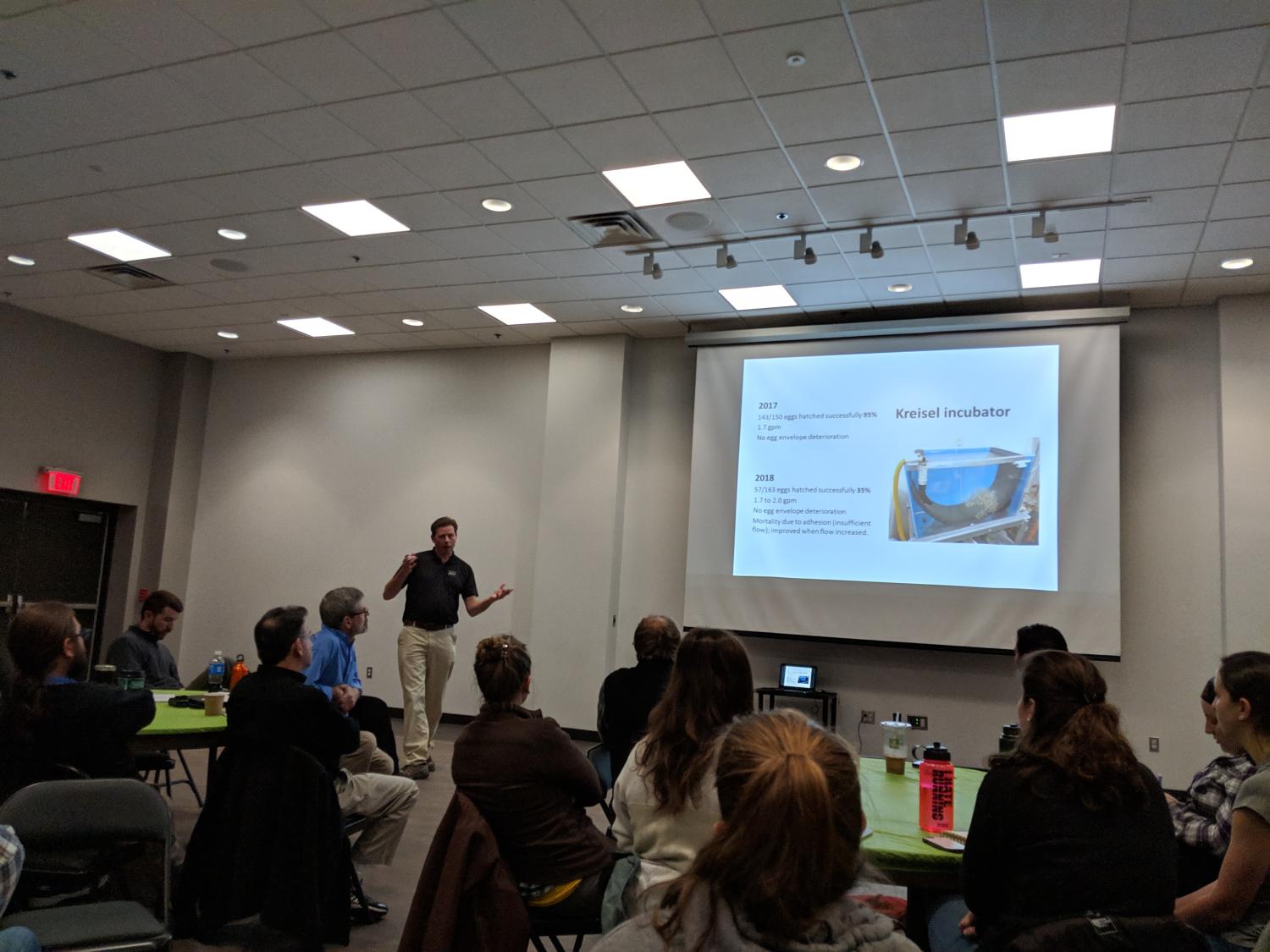
The zoos have led the way when it comes to rearing hellbenders. There have been a lot of challenges along the way. For example, we learned early on that when hellbender eggs don’t move, the embryos adhere to the egg wall and die. This was especially perplexing, since we knew from video borescope inspections of natural nests that there was no water movement inside the nest. It turns out, it’s the den master who shuffles the eggs around, by fanning them with his tail and crawling through the mass of eggs, plucking out the dead and diseased. The zookeepers addressed this by designing aquariums with a sloped bottom and rounded corners, similar to the Kreisel systems used to rear jellyfish, with pumps on timers to occasionally give the eggs a gentle rock around the tank.
Of course, rearing and releasing hellbenders isn’t much of a recovery plan if we’re not also working to restore their habitat. Multiple studies have found that the best predictor of the status of hellbenders is the amount of forest in their watershed, particularly the riparian forests where they reside and upstream. This isn’t surprising, as forests play a crucial role in retaining soil, filtering runoff, and shading streams. When forests are removed, water temperatures increase and excessive sediment washes into streams filling the nooks and crannies around rocks, essentially smothering hellbender homes. A recent study also found that male hellbenders are more likely to consume their nests in areas where there is less forest, perhaps because of dad picking up on environmental cues indicating a low chance of the young surviving. Saving your energy (and having a big meal!) to try again next year isn’t an unusual strategy for fish fathers that tend nests but could be an evolutionary trap for hellbenders, considering that it will take decades to substantially increase the amount of riparian forests.
Interactive map of Ohio stream segments in the range of the Hellbender color-coded by the amount of riparian forest within the segment and the upstream watershed, limited to a 100-meter buffer of contributing flowlines (50 m on each side). Hellbenders are mostly gone from streams with low amounts of forest (red segments that dominate western Ohio), while the highest forest cover is found in eastern Ohio (blue segments).
Riparian forests are most prevalent in the eastern portion of Ohio, making these areas some of the most vital to hellbender conservation. Members of the Ohio Hellbender Partnership include local parks, like the Knox County Park District and Columbiana County Park District, that have protected some of the finest riparian forests in the state and with them, important hellbender populations. Other partners include land trusts, including the Captina Conservancy and Western Reserve Land Conservancy, two organizations that protect important habitats through acquisitions and voluntary conservation easements.
Only 5% of Ohio’s land is publicly owned, meaning that recovery of the hellbender in the state requires the aid of private landowners. Even if we’re able to purchase and protect a segment of stream where hellbenders reside, what happens upstream – on private lands – can negate all of our efforts. This is where the work of our Soil and Water Conservation Districts (SWCD) is so important. In each county, SWCD staff work with landowners to address issues that degrade streams. This can range from cost-sharing for fencing to keep cattle out of streams, to dealing with streambank erosion.
Hellbender habitat has also been improved through the work of the Partners for Fish and Wildlife, a program of the U.S. Fish and Wildlife Service that helps landowners restore and enhance wildlife habitat. Partners biologists have planted trees to restore riparian forests, removed dams that fragment streams, and addressed fords, areas where vehicles drive through streams, to name just a few examples. Few things bring me as much excitement as bringing in the Partners to work with our local landowners to improve habitat, as they have an excellent track record of getting things done!
Back at the hut containing 982000365430857, the now 10-year-old, zoo-reared hellbender, the decision was made to collect some of the eggs he was guarding. These were brought back to the Columbus Zoo, where the resulting larvae are now being reared for release in 2026. A few more trips to the hut were made, but only to carefully peer through the tunnel with a video borescope. Dad was in attendance with every visit, and the remaining eggs were beginning to hatch in October!
Wildlife conservation can be a depressing vocation, which makes this milestone all the more worthy of celebration. I think every biologist has had the experience of writing a final report for a project, wondering if their list of “recommended nest steps” overshadows whatever accomplishments were made before the funding ran out. The Ohio Hellbender Partnership has been the exception, a program that continues more than a decade after its initiation.
This success is due to partners like the Columbus Zoo. Their unwavering support, and their recognition of the value of all of Ohio’s freshwater biodiversity, has made this possible.
We still have a long way to go. Our efforts are buying us time, as the hellbender is a long-lived animal (likely 30+ years). But in order for this to be more than a stop-gap measure, we need to do more to protect and restore our freshwater ecosystems in the state, not just for iconic species like the eastern hellbender, but for other amphibian species, and for freshwater mussels, fish, birds, and reptiles, not to mention our own drinking water!
You can help, by supporting the Columbus Zoo, your local park district and land trusts, by purchasing a Wildlife Legacy Stamp, and by advocating for programs that make a difference for Ohio’s wildlife, like Governor DeWine’s Rivers Initiative (part of the H2Ohio program), the voter approved Clean Ohio Green Space Conservation Program, and Recovering America’s Wildlife Act, currently being considered in the U.S. Congress. As Ohioans, we have the good fortune of living in a freshwater biodiversity hotspot, and it our collective responsibility to ensure all of this life continues to be a thriving part of our state’s natural heritage.
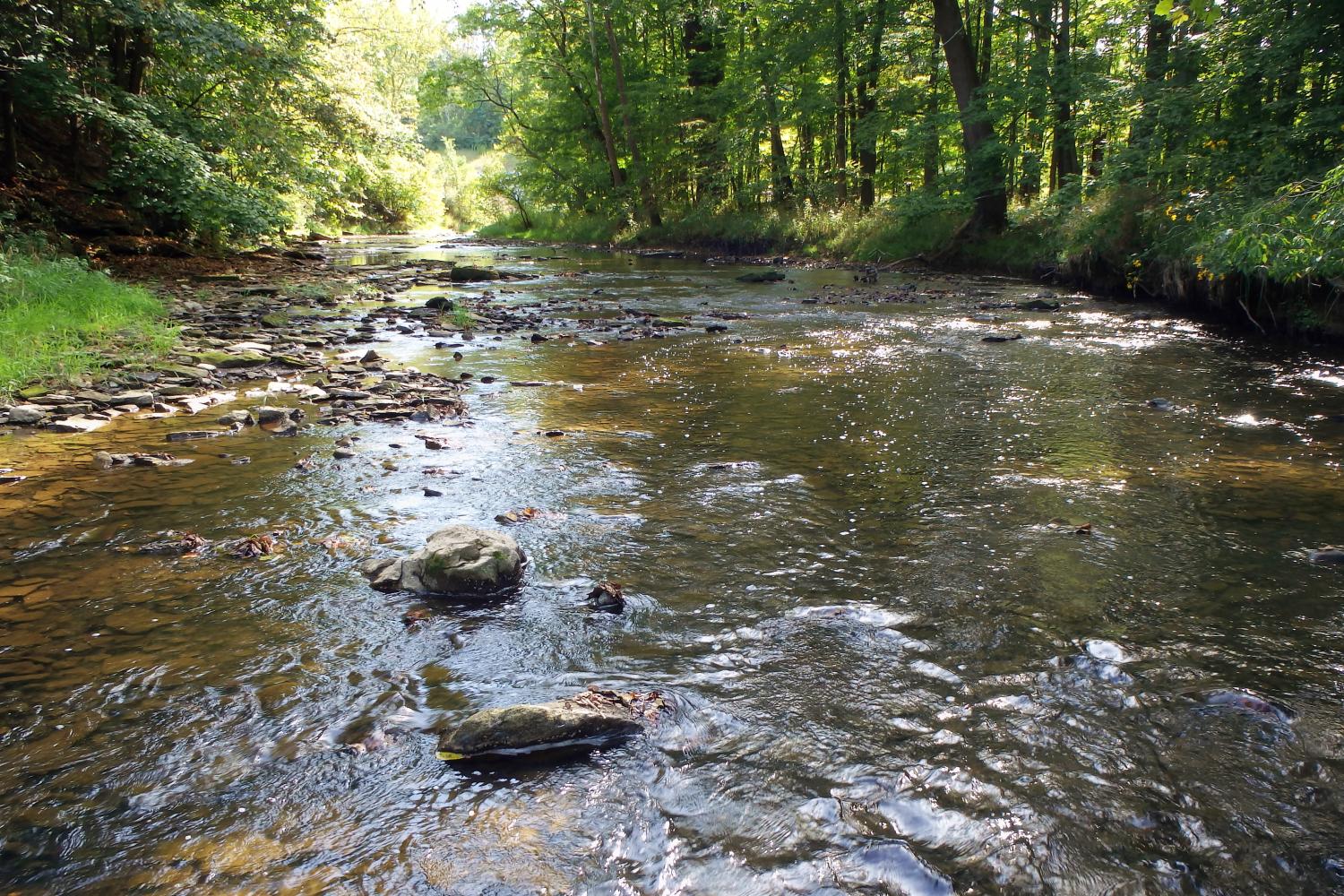
The Ohio Center for Wildlife Conservation will serve as a focal point for spotlighting the extraordinary local conservation initiatives spearheaded by the Columbus Zoo and The Wilds' dedicated teams. This vital work extends to a diverse range of species, from the elusive hellbender and plains garter snakes to the invaluable contributions of burying beetles and mussels, and the critical efforts in the realm of restoration ecology.
This ambitious project will not only provide a state-of-the-art facility for research and educational activities within the heart of the Zoo's North America Trek region, but will also elevate the awareness of the incredible local wildlife conservation work that is often overlooked.